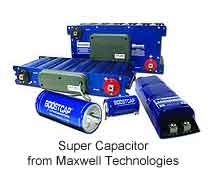Super Capacitor
Capacitors are electrical components that stores electrical energy and hence generally termed as electron banks. Their main purpose of a capacitor is to charge and discharge. If you do not know how capacitors work, read about capacitors and electrolyte capacitors.  In short, ceramic capacitors are constructed by alternating layers of ceramic and metal where ceramic acts as a dielectric. A classical electrolytic capacitor uses an electrolyte as a conductor between dielectric and an electrode. The bulky dielectric increases the size of capacitor, and hence the charge in electrolyte capacitor is limited to few millifarads. Recently super capacitors have received significant interest especially in the field of robotics due their high power density and cyclability compared to batteries, and high energy density compared to normal electrolyte capacitors. Unlike normal electrolyte capacitors, Super Capacitors, also known as EDLC (Electric Double Layer Capacitor) do not have traditional bulky dielectric material which separates electrodes. These capacitors exploit carbon technology, and when electric charge is applied to it, virtually create two layers of the same substrate; i.e. electric charge is stored at both sides of the carbon layer and hence rightly named Electric double layer capacitor. Since there is no actual bulky dielectric material present, thickness of dielectric formed by activated carbon is very thin which results in an extremely large plate with a weight of only a few grams. This large plate can store charge thousands of times more than a traditional electrolyte capacitor, and the charge in a Supercapacitor can be as large as 4000-5000 Farads.
In short, ceramic capacitors are constructed by alternating layers of ceramic and metal where ceramic acts as a dielectric. A classical electrolytic capacitor uses an electrolyte as a conductor between dielectric and an electrode. The bulky dielectric increases the size of capacitor, and hence the charge in electrolyte capacitor is limited to few millifarads. Recently super capacitors have received significant interest especially in the field of robotics due their high power density and cyclability compared to batteries, and high energy density compared to normal electrolyte capacitors. Unlike normal electrolyte capacitors, Super Capacitors, also known as EDLC (Electric Double Layer Capacitor) do not have traditional bulky dielectric material which separates electrodes. These capacitors exploit carbon technology, and when electric charge is applied to it, virtually create two layers of the same substrate; i.e. electric charge is stored at both sides of the carbon layer and hence rightly named Electric double layer capacitor. Since there is no actual bulky dielectric material present, thickness of dielectric formed by activated carbon is very thin which results in an extremely large plate with a weight of only a few grams. This large plate can store charge thousands of times more than a traditional electrolyte capacitor, and the charge in a Supercapacitor can be as large as 4000-5000 Farads.
When to consider a Supercapacitor?
As discussed, Supercapacitors have has almost unlimited cyclability and you can charge and discharge it as many times as you want, without destroying the electron bank. Design and construction of a Supercapacitor is as simple as using a battery; in fact you can combine a battery and a Supercapacitor when your requirement asks sudden a surge of charge. If you plan to use a solar powered robot, then there is nothing as useful as a Supercapacitor which can store the tiny charge produced from your solar cells to run your robot.
When not to consider a Supercapacitor?
Even Supercapacitors have limitations. They have low energy density and low working voltage compared to a battery. At least for the next few years, you cannot replace all batteries with Supercapacitors.
Supercapacitors are safe to use and more green compared to batteries. They don’t explode when you connect their opposite leads (although a conductor might turn red hot). They also don’t emit dangerous fumes while functioning. Use a Supercapacitor wisely and you would find numerous applications in robotics and electronics, especially in solar powered robots.
Do you have anything to say?
Visit the Forum to discuss, learn and share anything related to robotics and electronics !!








